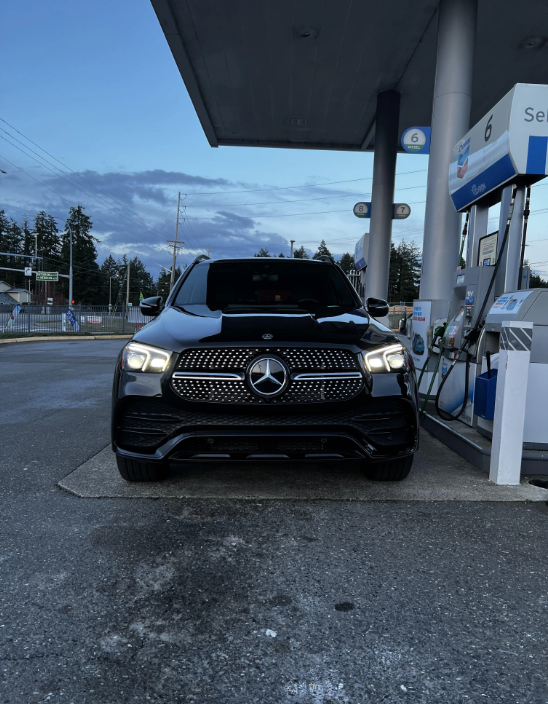If you�re a Mercedes GLE owner, you might wonder which gas type you should be using....
If you�re a Mercedes GLE owner, you might wonder which gas type you should be using.
And in that case, this article is for you!
Mercedes-Benz recommends premium gas with a minimum octane rating of 91 for the GLE. This is to ensure optimal engine performance and longevity. However, if premium gas is unavailable, the GLE can safely take regular gas (87 octane) or mid-grade gas (89 octane) temporarily.
By the end of this article, you�ll clearly understand why these recommendations exist.
So, let�s start!
At a Glance: What gas type does your Mercedes GLE need?
Before diving into the details of octane levels, let�s get straight to the answer many of you might be looking for.
After all, sometimes, all we want is a straightforward response, right?
For a regular Mercedes GLE: A regular Mercedes GLE like the GLE350, GLE400, or GLE450e needs premium gas (91 octane), according to the owner�s manual. However, regular gas (87 octane) can also be used temporarily. For AMG or high-performance models: Mercedes-AMG or high-performance models like the GLE580, GLE43 AMG, GLE53 AMG, or GLE63 S AMG require premium gas of at least 91 octane. However, Mercedes-Benz recommends 93 octane gas for optimal performance. Tuned Mercedes GLE: If you�ve given your Mercedes GLE an ECU tune (for example, using a RaceChip), fill it up using premium gas (at least 91 octane).Quick note: Occasionally filling up with regular (87 octane) or mid-grade gas (89 octane) won�t necessarily damage your car. But if you want the best for your vehicle long-term, sticking to the recommendations is the way to go.
If you prefer a table overview, here is what you should know:
| Gas | Regular (87 octane) | ! | Safe to use temporarily, although prolonged use might impair engine longevity and performance. |
| Gas | Mid-grade (89 octane) | ! | |
| Gas | Premium (91 octane) | ? | Recommended octane rating by Mercedes-Benz, which can prevent knocking sounds and prolong the engine life. |
| Gas | Premium (93 octane) | ? | |
| Gas | Ethanol-based (E10) | ? | Same as the typical gas at most pumps. |
| Gas | Ethanol-based (E15) | ! | Not optimal for the car, but it won�t be a danger in the short term. |
| Gas | Ethanol-based (E85) | ! | Mostly not OK. It can only be used if your Mercedes GLE has a flex-fuel system. |
| Gas | Reformulated Gasoline (RFG) | ? | A type of gas that burns more cleanly, about 30% of the gas sold in the US is RFG. (Source) |
| Additives | Fuel injector cleaner | ! | Be careful; it can potentially damage the engine when overused. |
| Additives | Octane booster | ! | Be careful; it can damage the engine when misused. |
| Additives | Fuel stabilizer | ! | Be careful; it can damage the engine when misused. |
Stick around if you�d like a deeper dive into why these recommendations exist. Otherwise, happy driving, and treat that Mercedes-Benz well!
Reader�s tip: 6 Best-Looking Wheels For Your Mercedes (OEM & Aftermarket)
Does the Mercedes GLE require regular or premium gas?
Time to dive a little deeper!
According to the Mercedes GLE owner�s manual, premium gas (91 octane) must be used for maximum engine output and longevity. However, if premium gas is not available, regular gas (87 octane) can be used temporarily:
That means you risk prematurely damaging the fuel system or engine by continuously using regular gas (87 octane).
Similarly, the engine of the Mercedes GLE is designed to reach its rated performance and fuel consumption values with premium gas (91 octane).
Tip: The correct gas type for your Mercedes GLE will always be written on the inside of the fuel filler flap.
If you own an AMG model of the Mercedes GLE, like the GLC43, GLC53, or GLC63 (S) AMG, premium gas (91 octane or higher) is a must.
While one tank of regular (87 octane) or mid-grade gas (89 octane) isn�t the end of the world, consistently using this gas type can lead to issues like engine knocking, reduced power, and even potential long-term engine damage.

And what about a tuned Mercedes GLE?
Modifications like RaceChip can significantly increase the power of your Mercedes GLE. But when you upgrade the engine�s performance, its gas needs an upgrade too.
Just as an athlete on a rigorous training regime needs specialized nutrition, a tuned Mercedes GLE requires premium gas (91 octane or higher).
Difference between regular, mid-grade, and premium gas
Fueling up might be a mundane task, but there�s a science to it.
Behind each pump, there�s a lot of chemistry going on to make our vehicles run smoothly.
So, if you�ve been wondering, �What do these octane numbers mean?� let�s take a look!
The octane rating of a gasoline type indicates its resistance to premature detonation or knocking.
In car terms, knocking is a rattling or pinging sound you�d hear when the air-fuel mixture in the cylinders detonates earlier than it should. It�s not good for your engine!
The higher the octane rating, the more compression the gas can withstand before it ignites, which reduces the likelihood of knocking and leads to smoother engine performance.
When you�re filling up, you will typically see the following gas types:
Regular gas (87 octane): Regular gas is the most common and least expensive type of gasoline available at most stations. It�s best for everyday vehicles that don�t demand high performance. Mid-grade gas (around 89 octane): As the name suggests, mid-grade gas sits between regular and premium gasoline in terms of performance and price. Perfect for those who want higher-quality fuel without paying too much. Premium gas (91 octane and above): Designed for high-performance engines, this gas resists knocking and ensures smoother combustion. It�s best for high-performance vehicles, luxury cars, and those with turbocharged engines.The main difference between regular, mid-grade, and premium gas is that regular gas has an octane rating of 87, mid-grade gas has an octane rating of 89, while premium gas has an octane rating of 91 or higher.

High-end cars (like Mercedes-Benz models) often have advanced engines that run on relatively high compression ratios. These engines thrive on the richness of premium gas, offering better acceleration, fuel economy, and longevity.
Real-world experiences with Mercedes GLE gas choices
Not convinced by the benefits of premium gas? Let�s check out some real-world experiences from Mercedes GLE owners!
1. Regular gas negatively impacting the driving experience
Here�s a story from a Mercedes GLE owner who experienced a much better driving experience after switching to premium gas (93 octane):
I took the delivery last year and I really wasn�t satisfied with the v6 in my GLE450. Until my go-to Shell station recently started to offer 93 octane gas.
The difference is significant enough which I feel I am driving a completely different car. The response, the power and the rev. It�s day and night.
She can�t reach 5000 rpm before even if I kick down, now I can easily get to redline on sports mode.
Mercedes is not joking about for maximum performance use gas higher than 91.
Source2. Using mid-grade gas
Here�s a GLE owner who found that mid-grade gas works well enough for them:
I have been using mid grade gas and it seems to work fine (89 octane) but have not gone to regular. I realize the factory recomends 91 gas but I do most of my driving around town so not really necessary to run 91. This is my third ML350 or GLE350 and no problems with mid grade at all.
Source3. The difference between premium and regular isn�t always noticeable
On the contrary, here�s someone who uses regular gas in their GLE43 AMG and has had no issues so far:
My Audi ran fine on regular fuel� and so does my GLE 43 AMG. Yes, my AMG runs on regular fuel�not premium! Maybe Karl Benz is rolling over in his grave, but I will never fill this car with premium fuel.
SourceCan you use ethanol-based fuels for the Mercedes GLE?
Ethanol-based fuels are fuels that contain ethanol, which is a renewable fuel made from biomass. Biomass consists of a variety of plant materials.
It looks something like this:

That�s a joke, of course!
In reality, over 98% of gasoline in the US contains ethanol. The most common ethanol-based fuel is E10, which consists of 10% ethanol and 90% gasoline.
Ethanol-based fuels reduce air pollution, but at the same time, using gas that contains a high concentration of ethanol can damage your vehicle.
E10 is a standard that�s commonly accepted to be safe for most cars on the road today, including the Mercedes GLE.
However, you may occasionally find E15 gas containing 15% ethanol and 85% gasoline. In the US, E15 can be found in 30 states at over 2,400 pumps (source).
E15 is not optimal for the Mercedes GLE, but it won�t be a danger in the short term.

Once you increase the ethanol percentage further, it really won�t be too good for your car.
For instance, E85 gas is also available in some places, but it can only be used for your Mercedes GLE if you have a flex-fuel kit.
FAQs about gas for the Mercedes GLE
If you have any more questions about which gas type to use for your Mercedes GLE, take a look at these FAQs:
What happens if I accidentally use regular gas in my Mercedes GLE?
Filling your Mercedes GLE with regular gas once won�t cause immediate harm. However, you might notice reduced performance and engine knocking. To prevent potential issues, it�s a good idea to top off with premium gas on your next fill-ups. Consistently using regular gas isn�t advised, as it can lead to premature engine wear.
Can I use fuel additives for the Mercedes GLE?
You can use fuel additives or cleaners for the Mercedes GLE. However, it is important to carefully read the manual beforehand and avoid using additives more than twice a year, as this can damage the engine or fuel system.
Can the Mercedes GLE take 93 octane gas?
Filling up a Mercedes GLE with 93 octane gas will allow it to extract its maximum performance and engine longevity. However, 91 octane is just as good unless you have a Mercedes-AMG or a high-performance model.
Final verdict
To summarize: You can temporarily use regular gas in the Mercedes GLE, but it�s highly recommended to use premium gas for the long term.
Mercedes-Benz recommends premium gas to preserve the engine and ensure your GLE continues driving as it should for years to come.
Sure, in the short run, you might save a bit by using regular gas. But think about the long game: lower fuel efficiency and potential repair bills.
Suddenly, those upfront �savings� might not feel so significant.
If you have any more questions, let us know in the comments!
Gas requirements for other Mercedes models
Are you interested in the required gas type of other Mercedes-Benz models?
If so, you can find everything you need to know in the following articles:
Mercedes A-Class gas type Mercedes C-Class gas type Mercedes E-Class gas type Mercedes S-Class gas type Mercedes GLA gas type Mercedes GLC gas type















